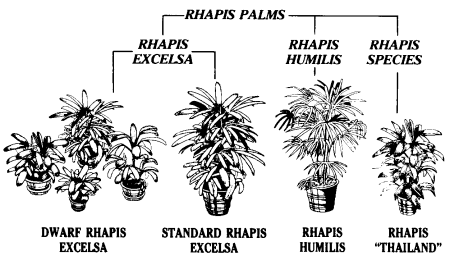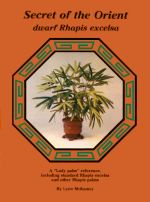

If this is the first book you have ever acquired about palms, and you know very little about them... don't feel alone. Few people have a yard full of palm trees, but everyone can have an exciting collection of indoor palms!
Palms are very different from most plants - they aren't trees, really... or flowers, although they do flower. Palms are in a class of their own. There are feather-leafed palms and fan-leafed palms; tall, single trunk palms and short, multiple trunk palms. Some are thorny porcupines of the plant world, while others are sleek graceful specimens. Some do have coconuts and monkeys, but most don't! You might be surprised to learn that over 3000 different species of palms exist, and quite a few are as happy indoors as they are in their native habitats.
My own search for the perfect indoor palm lead to a small clustering fan palm, known as the Rhapis excelsa - a native of the Far East. New to American interiors... or so I thought! An investigation of all indoor palms became a concentrated inquiry into just Rhapis. After merely finding a small article here or a brief description there, I quickly realized a lack of information about Rhapis. Serious sleuthing seemed to be the only recourse. My Rhapis Gardens greenhouses became a clearing house for any and all information from collectors, friendly competitors, growers, and botanists. These "informants" provided bits and pieces which assembled into a huge mound of material. Fact, fiction, and figures were checked, tested, and verified through cross references or experiments (some still in process after seventeen years). I soon had an "A to Z" file which seemed to cover every nook and cranny - or leaf and cane - of Rhapis!
I never really considered the historical aspect of palms until becoming involved with several Victorian restoration projects. Historical botanists found "Rhapis flabelliformis" listed in century-old documents, but were unsure of which Rhapis species this obsolete name indentified. My assignment concerned tracing and proving the correct, current botanical name of the Rhapis in question. This seemingly easy task evolved into a monumental effort of researching and cross referencing antique garden books to manuscripts of 19th and 20th century botanists (many of whom obviously didn't speak English since most of the papers were in German, French, and Latin.) Beware! Simple questions often require mountains of research! Oh and for those of you wondering - Rhapis flabelliformis turned out to be R.excelsa.
My original intent was a very brief handbook about Rhapis excelsa, but files began bulging with tidbits of information about all types of Rhapis. The book soon expanded and became a comprehensive reference of all forms of Rhapis palms - from ancient Oriental legends to current factual data.
The main subject of "Secret of the Orient" is dwarf Rhapis excelsa palms. Please note the word excelsa which specifies a certain species or kind of Rhapis palm. A common misconception is that all Rhapis palms are alike or one type. Actually, several other species are available, but are very unlike Rhapis excelsa in appearance, culture, and uses. You will soon learn why the Rhapis excelsa is the nicest "Lady" of all; why the Rhapis humilis is lovely, but usually unavailable; and why you should avoid having a very brief and disappointing affair with the unpredictable Rhapis "Thailand" which often masquerades as dwarf Rhapis excelsa or Rhapis humilis.

Notice the word DWARF which describes a certain type of Rhapis excelsa,
the only species with both large standard forms and smaller named varieties.
The primary difference between dwarf and standard excelsa is the maximum
mature height. Dwarf Rhapis excelsa slowly reach 8' in height, while
standard eventually attain 12'. Dwarf R. excelsa have many green
and variegated varieties; standard excelsa have only a few green forms
which are very much alike. You will find references to standard Rhapis
excelsa throughout Secret of the Orient - the history of
both large and small forms is intertwined. Rhapis excelsa were discovered
by Japanese in the 17th century and cultivated by the Samuri as a means
of extra income, collected by Europeans in the 18th century, then introduced
to America in the 19th century. Culture is basically the same for
both - just think big for standard and small for dwarf.
I have answered every question which anyone has ever asked me - from
"How did you get involved in an international secret?" to "What's so exceptional
about a dwarf Rhapis excelsa?" I am sure I have left out something
someone will want to know, but that will give me an excuse to write another
book or article. In the meantime, this Lady Palm guide should satisfy
your curiosity or enhance your interest in these delightful palms of the
Orient!
